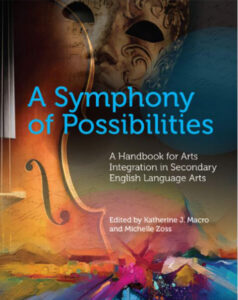NCTE member Timothy J. Duggan, a contributor to A Symphony of Possibilities: A Handbook for Arts Integration in Secondary English Language Arts, was invited to introduce an excerpt from his chapter (Chapter 1) in light of the current pandemic and the changes to our teaching environment.
I define teaching as a creative endeavor first and foremost.
Instructional design is a combined process of gathering materials, identifying concepts, practices, and outcomes desired, and then problem solving to create experiences for youth that maximize their potential for creative and analytical growth. Like any good artist, good teachers then reflect on their performance and continue practicing to get better at what they do and to help students develop their own expertise.
In a time that demands dramatic shifts in instructional delivery, we must rethink the relationship between teacher, student, and text (defined as broadly as possible). Faced with this challenge, we can either fold our tents and go hide in the woods, or we can adapt and build a better campsite.
This excerpt addresses the process of adapting literary texts to song, either through retelling stories, using song as commentary on text, or even getting into the weeds and creating individual musical signatures for characters, moments, and themes.
I would encourage teachers to extrapolate from the specific examples and ideas presented below to examine how we work as teachers. We can gather the materials necessary for synchronous or asynchronous teaching, then identify new and relevant concepts to explore, practices to develop, and outcomes to define and pursue with our students. With a mindset that considers possibilities rather than obstacles, we can solve the problems posed by our new reality in order to create a better, more connected, and more harmonious (pun intended) education for our students.
Think of our formerly configured classroom instruction as an original text that we have read hundreds of times, and that we once believed we understood deeply. Then take on the challenge of adapting and re-creating that text into a new manifestation that reframes our understanding of “learning together.”
We need creative thinking and competence across society in all times, not just in times of crisis. Songwriting is a safe and teachable process that places students in the roles of interpreter, translator, creator, problem solver, and critic. Skills learned in solving the problems of how to imagine, structure, and present a song can carry over into other and perhaps more consequential tasks in students’ lives.
I don’t just want students to learn creative thinking as an academic skill; I want them to choose creativity as a lifestyle—a choice that may create a better life for them and for all of us.
[Excerpt] Musical Adaptations and Explorations in English
As reflective teachers, we do well to consider how the work of school helps our students to make sense of the world and of their place in it.
One tool I’ve found useful in this regard is the parallel curriculum model developed several years ago (Tomlinson et al., 2002), which conceptualizes curriculum as having four parallels: the core curriculum, the curriculum of connections, the curriculum of practice, and the curriculum of identity. Essentially, the core curriculum includes key concepts and knowledge in a discipline. The curriculum of connections includes knowledge of how a discipline interacts with other disciplines. The curriculum of practice examines what kind of work is done in a discipline, how it’s done, and how professionals go about furthering the work. Finally, the curriculum of identity invites the learner to reflect on her relationship with the discipline.
For students in an English class, the connection between studying literature and songwriting will become clearer through the process of adapting stories into songs. In so doing, the students extend their knowledge of the practices of songwriters who take ideas, shape language, build a musical structure, and physically perform their art.
Perhaps most important, the students will see that the content of the English class and the process of writing a musical adaptation help to shape an emerging identity as artist/musician.
Even students who follow other paths in their careers will understand and appreciate the creative process of artist/musicians through the memory of constructing musical pieces inspired by the texts they encounter in English class. Conscientious teachers can exploit opportunities for students to discuss their various artistic responses to class texts and to reflect on how they see themselves fitting into the world of the artist and literary interpreter.
Adaptation is a sort of transformation, and part of the fun in adapting any story to a different format is to decide what remains rigidly faithful to the original text and what gets transformed.
In writing musical adaptations to literature, students cannot include every detail from the source text, so they are forced to solve the problem of how to retell the story (or concept), what is essential, and what must be cut for the sake of a three- or four-minute song. Students may also consider how transforming setting, both time and place, might affect the story they are retelling.
Several years ago, I took the story of Romeo and Juliet and turned it into a Western ballad. In order to remain faithful to the original, the lyrics in the first and last verses provided a prologue and epilogue (Duggan, 2008). With a 3/4 time signature to create the feel of a cowboy song, the opening lyrics were as follows:
In the town of Sioux City on the Western frontier,
Two households grew strong through the prosperous years,
But the feudin’ between them caused trouble and death
For two star-crossed lovers, Romeo and Juliet
In the song, Romeo’s father is a cattle rancher and Juliet’s father is a grain dealer and bootlegger. The friar becomes a preacher, the potion Juliet drinks is moonshine, and the Tybalt character shoots Mercutio in a gun battle, though neither is specifically named. The nurse’s role is cut, as are those of the other minor characters. Following the deaths of the two lovers, the last verse goes as follows:
In the town of Sioux City on the Western frontier,
Two households endured many sorrowful years
Put their feudin’ behind them, but they’ll never forget
Those two star-crossed lovers, Romeo and Juliet
The challenge in writing this adaptation of Shakespeare’s classic tragedy was to maintain enough of the emotional honesty to affect the listener, while also allowing for a few grins at the absurdity of the transposition to a new time and place.
Carefully selected quotes from Shakespeare’s text lent authenticity to the lyrics, and an ascending key change following Romeo’s banishment helped to build the dramatic tension in the song. I do not want to take a simplistic view of adaptation, as though it is just easy work that allows kids to be creative in class, or to feel as though they are creative, when they are really just being imitative.
Composing can be very difficult, and effective revision requires an extensive recursive process until every line in the lyric is valuable. The fun to be found through musical adaptation is in the work itself and the fruits of one’s labor.
Rather than another school assignment to be forgotten or tossed aside, this work can be remembered through the simple act of singing. In an age when students may negotiate their way through four years of high school and not produce one assignment that they will want to keep forever, it is just fine for them to exercise their creativity and enjoy the artistic products they produce.
One potential problem teachers may face in encouraging students to use music to build their understanding of classroom texts relates to how we assess those efforts. Ironically, perhaps, nonlinguistic manifestations of textual understanding, such as music, art, and dance, don’t necessarily free us from the need to use language to assess student performance on those tasks. Teachers may design rubrics with criteria they (and their students) determine to be vital elements of the artistic responses, but those rubrics rely on language to describe what was successfully developed by the student composer.
However, assessment of student musical compositions is not limited to language-based tools, such as rubrics or written feedback from the teacher. In Marcus’s case [a tenth-grader referenced earlier in this chapter], his rap song written in response to Esperanza’s story received applause from the other participants in the workshop when he performed it. This gave him immediate and tangible feedback on his work.
Similarly, students who post their musical creations on social media venues will receive feedback through the number of likes, the comments made by listeners, and/or the number of views tallied. Students who engage in adaptations and explorations of musical signatures and original lyrics build language, intersect it with music, and offer to their classmates and the world the marriage of the two.
Taking the step of getting students writing songs in class, setting poetic text to music, or making musical signatures for characters or scenes in a story will expand the dynamism of the classroom. Students will transform from witnesses of art into artists themselves—full participants. Witnessing has value; participation has significance.

This excerpt is reprinted from A Symphony of Possibilities: A Handbook for Arts Integration in Secondary English Language Arts (NCTE,2019), edited by Katherine J. Macro and Michelle Zoss.

Timothy J. Duggan is associate professor of Educational Inquiry and Curriculum Studies at Northeastern Illinois University.
It is the policy of NCTE in all publications, including the Literacy & NCTE blog, to provide a forum for the open discussion of ideas concerning the content and the teaching of English and the language arts. Publicity accorded to any particular point of view does not imply endorsement by the Executive Committee, the Board of Directors, the staff, or the membership at large, except in announcements of policy, where such endorsement is clearly specified.

